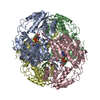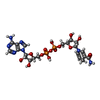[English] 日本語
 Yorodumi
Yorodumi- PDB-8c54: Cryo-EM structure of NADH bound SLA dehydrogenase RlGabD from Rhi... -
+ Open data
Open data
- Basic information
Basic information
| Entry | Database: PDB / ID: 8c54 | |||||||||||||||||||||
|---|---|---|---|---|---|---|---|---|---|---|---|---|---|---|---|---|---|---|---|---|---|---|
| Title | Cryo-EM structure of NADH bound SLA dehydrogenase RlGabD from Rhizobium leguminosarum bv. trifolii SRD1565 | |||||||||||||||||||||
 Components Components | Succinate semialdehyde dehydrogenase | |||||||||||||||||||||
 Keywords Keywords |  OXIDOREDUCTASE / Sulfolactaldehyde dehydrogenase NADH GabD OXIDOREDUCTASE / Sulfolactaldehyde dehydrogenase NADH GabD | |||||||||||||||||||||
| Function / homology | 1,4-DIHYDRONICOTINAMIDE ADENINE DINUCLEOTIDE Function and homology information Function and homology information | |||||||||||||||||||||
| Biological species |  Rhizobium leguminosarum bv. trifolii SRDI565 (bacteria) Rhizobium leguminosarum bv. trifolii SRDI565 (bacteria) | |||||||||||||||||||||
| Method |  ELECTRON MICROSCOPY / ELECTRON MICROSCOPY /  single particle reconstruction / single particle reconstruction /  cryo EM / Resolution: 2.52 Å cryo EM / Resolution: 2.52 Å | |||||||||||||||||||||
 Authors Authors | Sharma, M. / Meek, R.W. / Armstrong, Z. / Blaza, J.N. / Alhifthi, A. / Li, J. / Goddard-Borger, E.D. / Williams, S.J. / Davies, G.J. | |||||||||||||||||||||
| Funding support |  United Kingdom, United Kingdom,  Australia, 6items Australia, 6items
| |||||||||||||||||||||
 Citation Citation |  Journal: Chem Sci / Year: 2023 Journal: Chem Sci / Year: 2023Title: Molecular basis of sulfolactate synthesis by sulfolactaldehyde dehydrogenase from . Authors: Jinling Li / Mahima Sharma / Richard Meek / Amani Alhifthi / Zachary Armstrong / Niccolay Madiedo Soler / Mihwa Lee / Ethan D Goddard-Borger / James N Blaza / Gideon J Davies / Spencer J Williams /    Abstract: Sulfolactate (SL) is a short-chain organosulfonate that is an important reservoir of sulfur in the biosphere. SL is produced by oxidation of sulfolactaldehyde (SLA), which in turn derives from ...Sulfolactate (SL) is a short-chain organosulfonate that is an important reservoir of sulfur in the biosphere. SL is produced by oxidation of sulfolactaldehyde (SLA), which in turn derives from sulfoglycolysis of the sulfosugar sulfoquinovose, or through oxidation of 2,3-dihydroxypropanesulfonate. Oxidation of SLA is catalyzed by SLA dehydrogenases belonging to the aldehyde dehydrogenase superfamily. We report that SLA dehydrogenase GabD from the sulfoglycolytic bacterium SRDI565 can use both NAD and NADP as cofactor to oxidize SLA, and indicatively operates through a rapid equilibrium ordered mechanism. We report the cryo-EM structure of GabD bound to NADH, revealing a tetrameric quaternary structure and supporting proposal of organosulfonate binding residues in the active site, and a catalytic mechanism. Sequence based homology searches identified SLA dehydrogenase homologs in a range of putative sulfoglycolytic gene clusters in bacteria predominantly from the phyla Actinobacteria, Firmicutes, and Proteobacteria. This work provides a structural and biochemical view of SLA dehydrogenases to complement our knowledge of SLA reductases, and provide detailed insights into a critical step in the organosulfur cycle. | |||||||||||||||||||||
| History |
|
- Structure visualization
Structure visualization
| Structure viewer | Molecule:  Molmil Molmil Jmol/JSmol Jmol/JSmol |
|---|
- Downloads & links
Downloads & links
- Download
Download
| PDBx/mmCIF format |  8c54.cif.gz 8c54.cif.gz | 436.2 KB | Display |  PDBx/mmCIF format PDBx/mmCIF format |
|---|---|---|---|---|
| PDB format |  pdb8c54.ent.gz pdb8c54.ent.gz | 283.5 KB | Display |  PDB format PDB format |
| PDBx/mmJSON format |  8c54.json.gz 8c54.json.gz | Tree view |  PDBx/mmJSON format PDBx/mmJSON format | |
| Others |  Other downloads Other downloads |
-Validation report
| Arichive directory |  https://data.pdbj.org/pub/pdb/validation_reports/c5/8c54 https://data.pdbj.org/pub/pdb/validation_reports/c5/8c54 ftp://data.pdbj.org/pub/pdb/validation_reports/c5/8c54 ftp://data.pdbj.org/pub/pdb/validation_reports/c5/8c54 | HTTPS FTP |
|---|
-Related structure data
| Related structure data |  16433MC M: map data used to model this data C: citing same article ( |
|---|---|
| Similar structure data | Similarity search - Function & homology  F&H Search F&H Search |
- Links
Links
- Assembly
Assembly
| Deposited unit | 
|
|---|---|
| 1 |
|
- Components
Components
| #1: Protein | Mass: 52697.355 Da / Num. of mol.: 4 Source method: isolated from a genetically manipulated source Source: (gene. exp.)  Rhizobium leguminosarum bv. trifolii SRDI565 (bacteria) Rhizobium leguminosarum bv. trifolii SRDI565 (bacteria)Gene: EV132_10158 / Production host:   Escherichia coli BL21(DE3) (bacteria) Escherichia coli BL21(DE3) (bacteria)#2: Chemical | ChemComp-NAI /  Nicotinamide adenine dinucleotide Nicotinamide adenine dinucleotide#3: Water | ChemComp-HOH / |  Water WaterHas ligand of interest | Y | |
|---|
-Experimental details
-Experiment
| Experiment | Method:  ELECTRON MICROSCOPY ELECTRON MICROSCOPY |
|---|---|
| EM experiment | Aggregation state: PARTICLE / 3D reconstruction method:  single particle reconstruction single particle reconstruction |
- Sample preparation
Sample preparation
| Component | Name: Tetrameric assembly of RlGabD / Type: COMPLEX / Entity ID: #1 / Source: RECOMBINANT |
|---|---|
| Molecular weight | Value: 0.21 MDa / Experimental value: YES |
| Source (natural) | Organism:  Rhizobium leguminosarum bv. trifolii SRDI565 (bacteria) Rhizobium leguminosarum bv. trifolii SRDI565 (bacteria) |
| Source (recombinant) | Organism:   Escherichia coli BL21(DE3) (bacteria) Escherichia coli BL21(DE3) (bacteria) |
| Buffer solution | pH: 7.5 / Details: 50mM Tris, 300mM NaCl, pH7.5 |
| Specimen | Conc.: 1 mg/ml / Embedding applied: NO / Shadowing applied: NO / Staining applied : NO / Vitrification applied : NO / Vitrification applied : YES : YES |
| Specimen support | Grid material: GOLD / Grid type: UltrAuFoil R1.2/1.3 |
Vitrification | Instrument: FEI VITROBOT MARK IV / Cryogen name: ETHANE / Humidity: 100 % / Chamber temperature: 295 K |
- Electron microscopy imaging
Electron microscopy imaging
| Microscopy | Model: TFS GLACIOS |
|---|---|
| Electron gun | Electron source : :  FIELD EMISSION GUN / Accelerating voltage: 200 kV / Illumination mode: FLOOD BEAM FIELD EMISSION GUN / Accelerating voltage: 200 kV / Illumination mode: FLOOD BEAM |
| Electron lens | Mode: BRIGHT FIELD Bright-field microscopy / Nominal magnification: 240000 X / Nominal defocus max: 2000 nm / Nominal defocus min: 700 nm / C2 aperture diameter: 30 µm Bright-field microscopy / Nominal magnification: 240000 X / Nominal defocus max: 2000 nm / Nominal defocus min: 700 nm / C2 aperture diameter: 30 µm |
| Image recording | Electron dose: 50 e/Å2 / Film or detector model: FEI FALCON IV (4k x 4k) |
- Processing
Processing
| Software |
| ||||||||||||||||||||||||||||||||||||
|---|---|---|---|---|---|---|---|---|---|---|---|---|---|---|---|---|---|---|---|---|---|---|---|---|---|---|---|---|---|---|---|---|---|---|---|---|---|
| EM software |
| ||||||||||||||||||||||||||||||||||||
CTF correction | Type: PHASE FLIPPING AND AMPLITUDE CORRECTION | ||||||||||||||||||||||||||||||||||||
| Particle selection | Num. of particles selected: 437107 | ||||||||||||||||||||||||||||||||||||
| Symmetry | Point symmetry : D2 (2x2 fold dihedral : D2 (2x2 fold dihedral ) ) | ||||||||||||||||||||||||||||||||||||
3D reconstruction | Resolution: 2.52 Å / Resolution method: FSC 0.143 CUT-OFF / Num. of particles: 75165 / Num. of class averages: 1 / Symmetry type: POINT | ||||||||||||||||||||||||||||||||||||
| Refinement | Cross valid method: NONE Stereochemistry target values: GeoStd + Monomer Library + CDL v1.2 | ||||||||||||||||||||||||||||||||||||
| Displacement parameters | Biso mean: 24.17 Å2 | ||||||||||||||||||||||||||||||||||||
| Refine LS restraints |
|
 Movie
Movie Controller
Controller


 PDBj
PDBj




